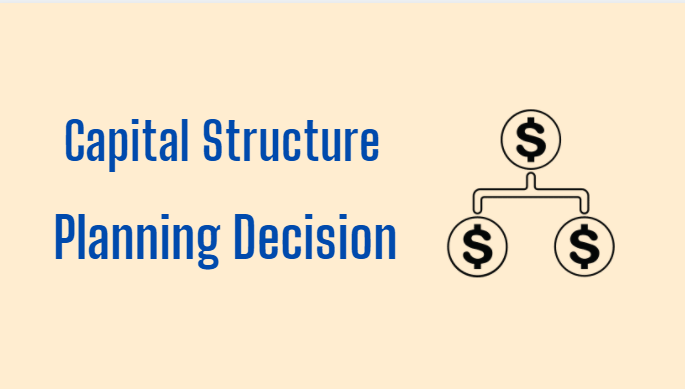Capital Structure Optimization for Mid-Sized Companies. How to Start Capital Structure Planning And Decision-Making? Estimation of capital requirements for current and future needs is important for a firm. Equally important is the determining of the capital mix.
Equity and debt are the two principal sources of finance for a business. The problem before the business is about the proportion of these sources and how much leverage it should employ.
To solve these problems the relationship between the financial leverage and the value of the firm or cost of capital has to be studied. Capital structure planning which aims at the maximization of profits and wealth of the shareholders ensures the maximum value of a firm or the minimum cost of capital. It is very important for the financial manager to determine the proper mix of debt and equity for his firm.
What are the primary factors influencing a company’s capital structure decision? Which we have to understand.
What is Capital Structure In Financial Management?
1. Trading on Financial Profit or Equity
2. Company’s tax exposure
3. Management Style
4. Business Risk
5. Growth Rate
6. Market Status
7. Financial Flexibility
8. Interest Coverage Ratio – ICR
9. Cash flow conditions
10. Debt Service Coverage Ratio – DSCR
11. Personal thoughts
12. Return on Investment-ROI
13. Cost of loan
14. Tax Rate
15. Flotation Cost
16. Cost of equity capital
17. Control
18. Stock Market Status
19. Regulatory Framework
20. Capital Structure of Other Companies
1. Trading on Financial Profit or Equity.
The use of long-term fixed interest-bearing debt and preference share capital along with equity share capital is called financial leverage or trading on equity. The use of long-term debt increases earnings per share if the firm returns more than the cost of debt.
Earnings per share also increase with the use of preference capital per share but due to the fact that interest is allowed to be deducted when calculating tax, the leverage effect of debt is greater.
However, leverage can also work adversely if the rate of interest on long-term debt exceeds the firm’s expected rate of earnings. Therefore, caution is needed to plan the firm’s capital structure.
2. Company’s Tax Exposure.
Debt payments are tax-deductible. For example, if the tax rate of a company is high, the use of debt as a means of financing a project is attractive. Because this tax deduction of debt payments saves some income from taxes.
3. Management Style.
Management styles range from aggressive to conservative. The more conservative a management approach is, the less inclined it is to use debt to increase profits. Aggressive management can try to grow the firm quickly, using significant amounts of debt to drive the company’s earnings per share (EPS) growth.
4. Business Risk.
Excluding debt, business risk is the basic risk of the company’s operations. The greater the business risk, the lower the optimal debt ratio. The total risk of a business depends on both operating risk and financial risk.
If the operating risk in business is less, the financial risk can be faced which means that more debt capital can be utilized. On the contrary, if the operating risk is high, the financial risk likely occurring after the greater use of debt capital should be avoided.
5. Growth Rate.
Those firms are in the development phase of their cycle. They usually finance. Growth through debt, borrowing money to grow faster. The opposition that arises from this method is that the growth firms’ revenues are usually volatile and unproven. As such, a high debt load is usually not appropriate.
6. Market Status.
Market conditions can have a significant impact on the state of a company’s capital structure. Suppose a firm needs to borrow money for a new plant. If the market is struggling, it means that because investors are limiting companies’ access to capital due to market concerns, the interest rate of borrowing may be higher than a company would like to pay.
In that case, a company may have to wait until the market returns to a more normal position before the company. Tries to use the money for the plant.
7. Financial Flexibility.
This is essentially the firm’s ability to raise capital in bad times. This is not surprising. Companies generally have no problem raising capital when sales increase and earnings are strong. However, given the company’s strong cash flow in good times, raising capital is not that difficult.
Companies should try to be prudent to raise capital in good times, not stretch their capabilities too far. The lower the company’s debt level, the higher the financial flexibility of the company is.
The airline industry is a good example. In good times, the industry generates significant volumes of sales and thus cash flow. However, in bad times, that situation is reversed and the industry is in a situation where it needs to borrow money.
If an airline becomes too debt-ridden, the ability to raise debt capital during these bad times may decrease, as investors may be skeptical of the airline’s ability to service its current debt. When a new debt is full on him.
8. Interest Coverage Ratio – ICR.
With the help of this ratio, an attempt is made to find out how often EBIT is available for payment of interest. The company’s ability to use its debt capital will be in direct proportion to this ratio. it’s possible.
Despite better ICR, the cash flow position of the company remains weak. Therefore, this ratio is not a reasonable or appropriate measure of a company’s ability to pay interest. Keeping the cash flow situation in mind is equally important.
9. Cash flow conditions.
Future cash flow conditions must be taken into consideration when making the choice of capital structure. Debt capital should be used only when the cash flow situation is really good. Because too much cash is required to pay interest and refund capital.
10. Debt Service Coverage Ratio – DSCR.
This ratio removes the weakness of ICR. This shows the cash flow position of the company.
This ratio tells us the number of cash payments to be made (eg, preference dividends, interest, and debt capital repayments) and the amount of cash available. A better ratio means the company’s superior ability to pay off debt. As a result, more debt can be used in the capital structure.
11. Personal thoughts.
Personal considerations and management capabilities will have the final say on capital structure. Management that is experienced. And are very enterprising, and they do not hesitate to use more debt in their financing than less experienced and conservative management.
12. Return on Investment-ROI.
Higher returns on a company’s investment increase its ability to use more debt capital.
13. Cost of Loan.
A company’s ability to borrow depends on the cost of the loan. If the rate of interest on debt capital is low, then more debt capital can be used and vice versa.
14. Tax Rate.
The tax rate affects the cost of the loan. If the tax rate is high, the cost of the loan decreases. This is because. It cuts interest on debt capital from profits, considering it a part of spending and saving on taxes.
15. Flotation Cost.
Floatation costs are those costs incurred at issuing Securities (eg, equity shares, preference shares, debentures, etc.). These include the commission of the underwriter, brokerage, stationery expenses, etc. Debt capital issuance costs are generally lower than share capital. This attracts the company towards debt capital.
16. Cost of equity capital.
The cost of equity capital (this means equity shareholders’ expectations from the company) is affected by the use of debt capital. If debt capital is overused, it will increase the cost of equity capital. The simple reason for this is. That excess use of debt capital increases equity shareholders’ risk.
17. Control
According to this factor, while designing the capital structure, it should be ensured that the control of the existing shareholders (owners) over the affairs of the company is not adversely affected.
If the funds are raised by issuing equity shares, the number of company shareholders will increase and this directly affects the control of existing shareholders. In other words, the number of owners (shareholders) controlling the company now increases.
18. Stock Market Status.
The state of the stock market refers to an upward or downward trend in the capital market. Both these situations have their effect on the selection of sources of finance. When the market is sluggish, investors are afraid to invest in share capital due to the high risk.
Conversely, when conditions in the capital market swell, they consider investing in share capital as the best option for a profit. Therefore, companies should choose capital sources keeping in mind the prevailing conditions in the capital market.
19. Regulatory Framework.
Capital structure is also influenced by government regulations. For example, banking companies can raise money by issuing share capital alone, not any other type of security. Similarly, it is mandatory for other companies to maintain the given debt-equity ratio while raising funds.
20. Capital Structure of Other Companies.
Capital structure is influenced by the industry a company is related. All companies belonging to a given industry produce almost the same products, they have the same cost of production, they depend on the same technology, they have the same profitability, and therefore the pattern of their capital structure is almost the same.
Due to this fact, different debt-equity ratios are prevalent. Various industries. Therefore, at the time of raising funds, a company should take into account the debt-equity ratio prevailing in the industry concerned.
Conclusion.
Optimizing capital structure is essential for mid-sized companies in India to enhance financial stability and drive growth.
By carefully balancing debt and equity, these companies can improve their liquidity, reduce financing costs, and increase overall profitability.
Understanding the unique determinants of capital structure, such as asset tangibility, profitability, and market conditions, allows businesses to make informed financing decisions.
As mid-sized firms navigate the complexities of the Indian market, a well-structured capital strategy will not only mitigate risks but also position them for sustainable success in an increasingly competitive environment.
Emphasizing the importance of tailored financial solutions and strategic planning will empower these companies to thrive and adapt to changing economic landscapes.








